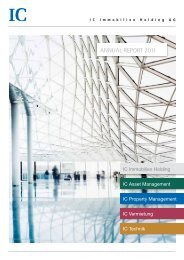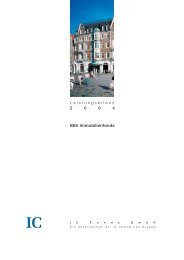Utilization of Tunnels as Sources of Ground Heat - iC group of ...
Utilization of Tunnels as Sources of Ground Heat - iC group of ...
Utilization of Tunnels as Sources of Ground Heat - iC group of ...
You also want an ePaper? Increase the reach of your titles
YUMPU automatically turns print PDFs into web optimized ePapers that Google loves.
selected positions with temperature sensors (diaphragm<br />
walls, invert <strong>of</strong> the station tunnels, underneath<br />
the b<strong>as</strong>e slab), which are used in the operating<br />
ph<strong>as</strong>e for scientific purposes and for control and<br />
plant optimization.<br />
4.7 Initial operation<br />
After completion <strong>of</strong> the civil works, the responsibility<br />
for the completion <strong>of</strong> the geothermal facility usually<br />
is turned over to an installation company, which<br />
completes the HVAC equipment. An accurate definition<br />
<strong>of</strong> the contractual and technical interface between<br />
these companies, connected with acceptance<br />
inspections, is therefore essential. Mechanical engineers<br />
and geothermal planners should accompany<br />
the facility in the first operational years and optimize<br />
it together with the client.<br />
Figure 11: Monitoring equipment in diaphragm wall reinforcement<br />
cage.<br />
5 CONCLUSION<br />
<strong>Utilization</strong> possibilities <strong>of</strong> geothermal energy for<br />
heating and cooling purposes are various. Each tunnel<br />
h<strong>as</strong> significant internal energy requirements.<br />
This is clearly evident particularly with metro stations,<br />
where various premises must be heated and<br />
cooled. A further field <strong>of</strong> application is ice prevention,<br />
particularly with stairc<strong>as</strong>es or entries to maintenance<br />
and evacuation adits.<br />
Beyond that the possibility <strong>of</strong> selling geothermal<br />
energy to third parties exists. This is interesting<br />
above all for tunnels in the city (metros), where they<br />
are usually situated near to the surface and distances<br />
to the users are short. Large, newly established objects<br />
with mixed living and commercial use and a<br />
high cooling demand are ideal.<br />
The geothermal utilization from traffic tunnel<br />
buildings <strong>of</strong>fers benefits to all involved. Economically,<br />
a pollution-free, renewable energy source is<br />
developed, which is import independent and makes a<br />
contribution to climate protection and to the fulfillment<br />
<strong>of</strong> international obligations (Kyoto Protocol).<br />
The user <strong>of</strong> the geothermal energy receives a pipebound,<br />
pollution free energy source with all benefits<br />
<strong>of</strong> such systems. Additionally geothermal energy<br />
will represent a more economical form <strong>of</strong> energy in<br />
the medium term than fossil energy sources, especially<br />
if corresponding political me<strong>as</strong>ures are taken.<br />
For the owner <strong>of</strong> the tunnel the geothermal energy<br />
<strong>of</strong>fers the possibility <strong>of</strong> opening additional sources<br />
<strong>of</strong> income from the structure and <strong>of</strong> lowering operating<br />
costs. Furthermore the application means a gain<br />
in public image because <strong>of</strong> the pollution free and innovative<br />
character <strong>of</strong> such geothermal facilities.<br />
REFERENCES<br />
Adam, D., Markiewicz, R. (2003): Geothermische Energienutzung<br />
im Bauwesen. Heft 54/Oktober 2003. Österreichische<br />
Vereinigung für Beton- und Bautechnik. Wien.<br />
Bayer, R. (2003): 22 Jahre Energienutzung über erdberührte<br />
Betonabsorber. Heft 54/Oktober 2003. Österreichische Vereinigung<br />
für Beton- und Bautechnik.<br />
Brandl, H. (1998): Energy piles and diaphragm walls for heat<br />
transfer from and into ground. 3rd International Geotechnical<br />
Seminar, Deep Foundations and Auger Piles III. University<br />
<strong>of</strong> Gent, Belgium. Proceedings: A.A. Balkema, Rotterdam.<br />
Brandl, H., Adam. D.(2002): Die Nutzung geothermischer Energie<br />
mittels erdberührter Bauteile. In: Festschrift der Universität<br />
für Architektur "Geotechnique" Vol. XL (1999-<br />
2001), S<strong>of</strong>ia, Bulgarien.<br />
Brandl, H., Markiewicz, R. (2001): Geothermische Nutzung<br />
von Bauwerksfundierungen ("Energiefundierungen"). In:<br />
ÖIAZ, 146.Jg., Heft 5-6/2001, Wien.<br />
Markiewicz, R., Adam, D. (2003): Utilisation <strong>of</strong> Geothermal<br />
Energy using Earthcoupled Structures – Theoretical and<br />
Experimental Investigations, C<strong>as</strong>e Histories. In: Geotechnical<br />
Problems With Man-Made And Man Influenced<br />
<strong>Ground</strong>s. XIII th European Conference on Soil Mechanics<br />
and Geotechnical Engineering. Volume 2. 25-28 th August<br />
2003, Prague.<br />
Nägelebau Energie- und Haustechnik GmbH (2000): Enercret.<br />
Promotion-CD Version 1.0.<br />
Unterberger, W., Adam, D., H<strong>of</strong>inger, J. (2002): Erdwärmenutzung<br />
im Verkehrstunnelbau. Zement+Beton 4/02. Zement+Beton<br />
Handels- und Werbeges.m.b.H., Wien.
















